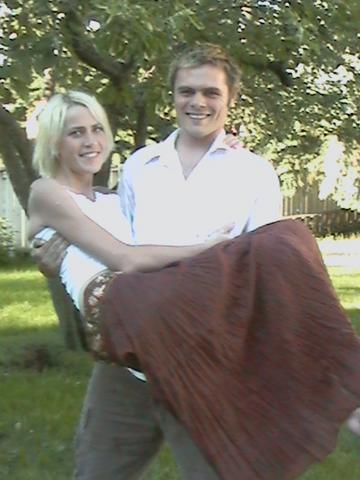dealing with chaos
in a perfect world i wouldn't have to scream she told me as her consequences caught up with her. they wrapped around her like a black scarf and pulled her down into reality. she reminded me of edward munch's 'the scream,' swirling colours a tiny person being swallowed up by her own noise. sometimes we just have to sit and let ourselves be quiet, i caution, and then proceed to yell at the top of my lungs. my own masterpiece -- 'the yell.' perhaps i'll paint it. that's easier than following my own advice.


3 Comments:
I believe it was Edvard Munch who painted the Scream (you should post a picture of the painting):
The Scream a.k.a. The Cry (1893)
Tempera and pastel on board. 91 x 73.5 cm.
Signed lower left: E. Munch 1893
Presented in 1910 by Olaf Schou
Edvard Munch and his best-known work
As a gifted Norwegian painter and printmaker, Edvard Munch not only was his country's greatest artist, but also played a vital role in the development of German expressionism. His work often included the symbolic portrayal of such themes as misery, sickness, and death. The Cry or The Scream, was probably his most familiar painting, and it is typical in its anguished expression of isolation and fear.
His intense, evocative treatment of psychological and emotional themes was a major influence on the development of German Expressionism in the early 20th century. His painting The Scream or The Cry (1893) is regarded as an icon of existential anguish.
Munch was born on Dec. 12, 1863, in Loten, Norway. He grew up in Christiania (now Oslo) and studied art under Christian Krohg, a Norwegian naturalistic painter. Munch's parents, a brother, and a sister died while he was still young, which probably explains the bleakness and pessimism of much of his work. Paintings such as The Sick Child (1886), Vampire (1893-94), and Ashes (1894) show his preoccupation with the darker aspects of life.
Munch traveled to Paris in 1885, and his work began to show the influence of his French painters—first, the impressionists, and then the postimpressionists—as well as art nouveau design. Like many young artists Munch reacted against conventional behavior, and in 1892 he took part in a controversial exhibit in Berlin. His circle of friends included several writers, one of whom was the Norwegian playwright Henrik Ibsen. Munch designed the sets for several of Ibsen's plays.
Between 1892 and 1908, Munch spent much of his time in Paris and Berlin, where he became known for his prints—etchings, lithographs, and woodcuts. After 1910, Munch returned to Norway, where he lived and painted until his death. In his later paintings Munch showed more interest in nature, and his work became more colorful and less pessimistic. Munch died in Ekely, near Oslo, on January 23, 1944. He left many of his works to the city of Oslo, which built a museum in his honor.
Edvard Munch's most famous work has gained enormously in popularity, especially since World War II. Is it possible that the existential fear rendered in this work by the artist has become more widespread in recent decades?
When art historians call Munch, together with artists like Van Gogh, "the founder of Expressionism", it is because of a picture such as The Scream. The work depicts not so much an incident or a landscape as a state of mind. The drama is an inner one, and yet the subject is firmly anchored in the topography of Oslo—the view is from Nordstrand towards the two bays at the head of the Oslofjord, with Holmenkollen in the background. The evening landscape has been distilled into an abstract rhythm of wavy lines. The road with its railing, leading diagonally inwards, creates a powerful pull of perspective in the composition, and intensifies the disquieting atmosphere in the picture.
In the foreground, on a road with a railing along it, we see a figure: his hands raised to his head, eyes staring, mouth gaping. Further back are two men in top hats, and behind them a landscape of a fjord and hills. The first time Munch described the experience which gave rise to this painting was in Nice, writing in his literary diary. The entry for 22 January 1892 reads:
"I was walking along the road with two friends. The sun was setting. I felt a breath of melancholy—suddenly the sky turned blood-red. I stopped, and leaned against the railing, deathly tired— looking out across the flaming clouds that hung like blood and a sword over the blue-black fjord and town. My friends walked on—I stood there, trembling with fear. And I sensed a great, infinite scream pass through nature."
woops, thanks keith! i should really have known that. and i would post the painting except i don't know how! love you!
"they wrapped around her like a black scarf and pulled her down into reality."
Just a really great part I had to point out! Love how you used the scarf to bring her back to reality. I dunno, a scarf can be confining, but can also be protection too..? Maybe from reality itself?
"sometimes we just have to sit and let ourselves be quiet, i caution, and then proceed to yell at the top of my lungs."
This sounds almost like giving up.. by yelling when they know they should be silent..like they can't hold something in anymore..blah! I love all thesssee!
Post a Comment
<< Home